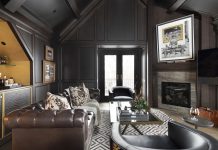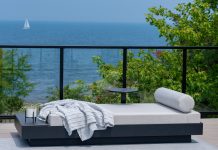Minimalist architect Ludwig Mies van der Rohe didn’t originate the phrase “Less is more,” but he adopted it as his philosophy. It aptly describes the transformation of a house in Minneapolis that was anything but minimal when it was built in 1905.
Cosmopolitan describes the couple that commissioned the makeover. David Meline left his hometown of Owatonna for college and never looked back—that is, until he was tapped for a plumb job at 3M (he is now the company’s CFO). He met his wife, Barbara, in Africa. They traveled together, got married, and traveled some more as David leveraged his math skills into a glamorous globetrotting career.

“By now, the world feels pretty small,” David says. Maybe that’s why Minneapolis seemed not such a stretch. Their then-teenage sons took to it right away. “The quality of life here is very nice,” says Barbara.
For three years, the family rented a house while they scoured the city for a permanent residence. Lars Peterssen of Peterssen/Keller Architecture was recruited to help them, and when a house on Lake of the Isles that had been designed by the legendary architect Harry Wild Jones came on the market, he urged them to snap it up. “It had everything we wanted,” Barbara says.
Well, almost everything. On the plus side, Peterssen recalls, were “great bones and the best location in town.” The size was right, too, at just under 4,000 square feet. But whereas the first owners had nine children and probably half as many servants, David and Barbara are now empty nesters. Cubicle living isn’t their style. “Modern is what I grew up with,” She says simply

The couple kept the original red-tile roof and cornices. The handsome cottage-style porch windows were falling apart, so near-identical new ones were custom made. Several decorative windows remain as well. Otherwise, the rule was everything goes.
“It was a blessing, in a way, that the house had already undergone several remodels,” Peterssen says. “Even though it was designed by an important architect, the interior didn’t feel sacred.”
Together with the project’s lead architect Kristine Anderson, Peterssen proposed replacing the interior’s Moorish-style, faux-stone finishes with a palette of pale gray and white. But the primary transformation involved bringing the large wraparound porch into the living and dining rooms.
The original stone foundation extends to the edges of the porch, unusual for its time and fortuitous for the architects. Their design eliminated the brick walls dividing the porch and living room, and added steel supports in the beamed ceiling to carry the load. The new space is filled with sun in the daytime as well as glorious views of the lake to the east and the Kenilworth Lagoon to the south; it glows under its soft, new recessed lighting at night.

A wall and doorway that divided the sitting and living rooms also came down, bringing in the northern light and giving this part of the much-enlarged space those spectacular views. A wall that had obscured a wrought-iron bannister leading upstairs also came down, and a new matching bannister balances the now-exposed steps.
Floors of rift-sawn oak, notable for its fine-grained straight lines, flow from the front of the domino-shaped house to the back. The same wood forms the mantel of the sitting room’s wall-to-wall fireplace, which became an important focal point with its strong horizontal line. The gray-ribbed stone surround seems to float above blackened-steel panels on either side of the recessed fireplace. Steel shelves below the mantel show off, among other treasures, a pair of handsome ceramic pots made by the Melines’ artistic younger son, Michael, who hopes to become an architect.

Bright colors are few but the more dramatic for it. Above the mantel hangs a fiery-hued painting the couple acquired in Vietnam. A classic midcentury armchair and ottoman are upholstered in lime green. Barbara loves the chair. David finds it uncomfortable. On everything else, the Melines are in perfect accord.
Art Deco is among their many shared interests. Their collection includes a freestanding burled-maple bar with a fluted front and an exquisite sideboard flanked by a pair of Art Deco side chairs. Above the sideboard is a mirror with light fixtures of similar vintage on either side of it.

The Melines’ global finds add warmth and whimsy. A comfy green-velvet upholstered English Art Deco chair made in the 1930s sprouts a pair of hinged side tables. An African bone and mahogany armchair mimics a seated person. A curvaceous chest of drawers in the sitting room, handcrafted for David in Kenya by an eccentric Dutchman, could have been the brainchild of Dr. Seuss.
“It’s survived four continents,” says Barbara, who confesses to being a ferocious packer. “But we’ve never lost anything.” Not even two African pots, each weighing 200 pounds.
Frosted-glass pocket doors open onto a state-of-the-art kitchen. Anderson and Peterssen had to think big to pare down this space, which formerly housed an angled island, a brick chimney, and a large pantry.

Not anymore. The redesign made space for bookshelves and a small sitting area. The rest of the kitchen is all about food. David picked out the prep island’s smoky granite countertop. A slab of rift-sawn oak is mounted low enough on the island to seat four in comfortable and stylish armchairs instead of the usual stools.
The kitchen’s upper cabinets are made of the same fine-grained oak. Barbara insisted on acid-etched frosted glass for the lowers and backsplash. “It’s easy to clean and doesn’t show fingerprints,” she explains. Extruded pulls complete the clean look.
The couple’s devotion to the “Less is more” design philosophy had only one drawback: It created a bit of a storage problem.
“Everywhere we could think of, we scavenged space,” Barbara says with a sly smile. Like a magician pulling a rabbit out of a hat, she opens a skinny door almost invisible to the naked eye. Behind the door is an exceptionally well-organized broom closet.

Architecture: Kristine Anderson & Lars Peterssen of Peterssen/Keller Architecture



















